|
G r e e c e Pictures of my first two visits with Gerhard 1953
+ 1954 Google-Earth
kmz-file 1954 |
Greece had been my dream ever since my father had given me Kästner's book "Griechenland" with Kaulbach's drawings for Christmas in 1943. A young woman from New Zealand, whom we met in Florence in 1952, had encouraged us, it was possible, the murderous Greek civil war was over. We worked in a saltmine near Hanover all during Spring vacations to make the money. I bought a real camera, a Diax, and many rolls of my first color film (AGFA-Chrome), and we set out by autostop from Göttingen as soon as the semester had ended. This 3-month journey would become the most important experience, my dreams are still filled with the pictures you will see.
This year we walked, for almost 3 months. It all began in Italy, where we hitch-hiked down the east coast to Brindisi. In Ravenna we met with Marianne Daeg, the same friend who would eventually join us on our expedition to Western Tibet in 1995.
|
|
Ravenna, The Mosaics of San Vitale
She waited at the youth-hostel in Ravenna - in short Lederhosen, a Finnish knife in one side pocket! A sensation.
|
The beach at Porto Reccanati |
Our strange Trio in Porto Reccanati |
Embarrassed by our wild-looking companion we hitch-hiked separately and met her again in Ancona. It was not difficult to find her, she had arrived long before us and was waiting surrounded by a crowd of teasing men at the main square. Together we hiked a few kilometers further and put up for the night, a thunderstorm was brewing, in Porto Reccanati in the beach house of the local Asilio Infantile. The picture was taken on the following morning with the caretaker clowning in the background. Thank God, we did not understand enough Italian!
|
|
Camping in the open near Ancona - Marianne took the photo.
|
|
Walking along the Adriatic coast south towards Greece
We dawdled another day at the beach and finally separated. I don't remember where to Marianne went, we hitch-hiked along the coast and reached Brindisi at two in the morning three days later.
In Brindisi we bought tickets for the boat to Athens - and at the shipping agency unexpectedly ran into Georgios Statakopoulos, a Greek friend from Göttingen. He had a German woman in tow whom he had met at a Faschingball in Göttingen.... The frightened girl was six months pregnant! When they got off the boat in Patras, Georgios invited us to their wedding two weeks hence.
On the boat we slept for two nights under an unimaginable canopy of stars on the fore deck of the rusty old MS. Kyklades. In the middle of the second night the boat anchored between Ithaka and Kefallonia, Odysseus' islands, to pick-up scores of women in black and their crying children and take them to Patras, the frightened survivors of a 7.2 earthquake which had ravaged the islands two nights earlier. Standing tightly packed they were rowed across the heaving dark sea to our ship in open boats from which they had to clamber aboard up a swaying rope ladder - like we would be compelled to do many times in the years to come.
Akrokorinthos from the sea. Very early next morning as the sun rose we lay for an hour at the entrance to the Korinthian canal..
|
|
The aging Kyklades thoroughly smoked up the tunnel-like canal.
We arrived in Piraeus (pronounced Pireev) on the day of Metamorphosis, Christ's appearance at Mt. Tabor, a to us only dimly remembered event, but one of the most sacred religious holidays of Eastern Orthodoxy. All banks and offices were closed. We had to borrow money for the subway to Athens. For a long day we searched the dusty, wind-swept town for a place to stay only to be offered in the end a free room in a hostel run by the mother of another Greek student from Göttingen....
Thus between tragedy and hospitality began my love affair with Greece which has endured fifty years. In 1953 we walked for eight weeks through the heart of the Peloponnisos high on the merciless Greek light and classical architecture. The photographs taken in this euphoria with my first camera have not been surpassed. Many of the Agfa-color slides are so faded and scratched that I cannot show them any longer, but modern computer technology has allowed me to restore them to their old glory.
Athens
14 August - 10 September 1953
|
|
Fascinated by the chaotic Near-Eastern life of the dusty city, we waited for a week before we ventured to face the Acropolis, which was the real attraction we had come to see.
The Acropolis
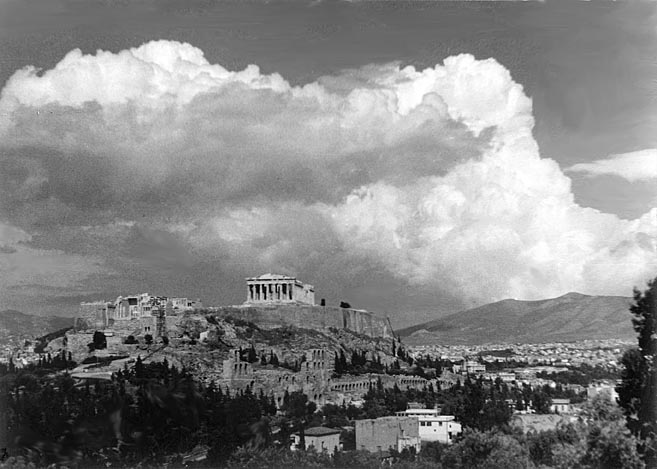
|
The Acropolis from the hill of Pholopappos
The entrance to the Acropolis from the west.
|
|
The Parthenon from the Propyleae
.
Propyleae looking west. There were very few tourists in those days, especially during the hot noon. Gerhard on the left seems to be the only one. And one was permitted to enter the buildings.
The gaping hole in the south-side of the Parthenon was shot by an artillerist from Braunschweig in Turkish wars of the 19th century. The Turks had a powder depot in the temple.
The Lykabettos from the Parthenon.
|
|
Erechthion and the columns of the Parthenon
Erechthion during high noon.
One of several photographers who pursued the tourists and delivered a paper print from his box in five minutes.
.
|
|
The Korai. The third in the row is a copy, the original, like the frieze of the Parthenon were removed by Lord Elgin and since hibernates in the gray light of the British Museum in London.
.
|
|
In the northern hall of the Erechthion Poseidon's trident was kept.
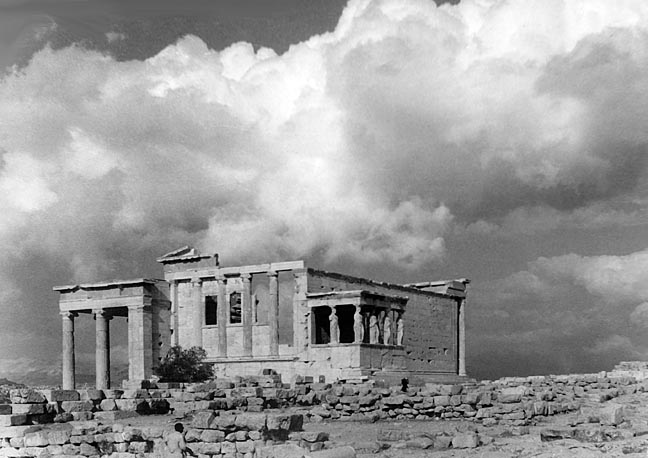
|
One glorious day big clouds hung over Athens, the perfect day for black-and-white photographs
The Hymettos in the evening light seen from the Parthenon
Athens and the Pentelikon through the northern columns of the Parthenon. The straight avenue is Patission where we had found a place to stay in a student dormitory.
Another view of Hymettos from the Parthenon
The west side of the Parthenon. Compare this picture with that of the "Poseidon" Temple in Paestum, Italy at the end of this diary and you will recognize the genius of the architect Ichtinos who built it at much the same time as Paestum....
The small temple of Athena Nike rests on a free-standing pedestal high above the stairs to the Propyleae.
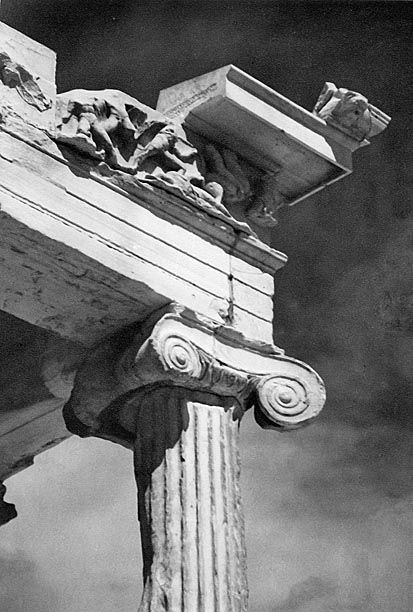
|
Ionian corner column of the Nike temple
View from the Prolyleai in the evening. In the distance one sees the island of Salamis and the narrow straight were the Persian armada was defeated and Athens was saved by Perikles.
Dionysos Theater seen from the Acropolis.
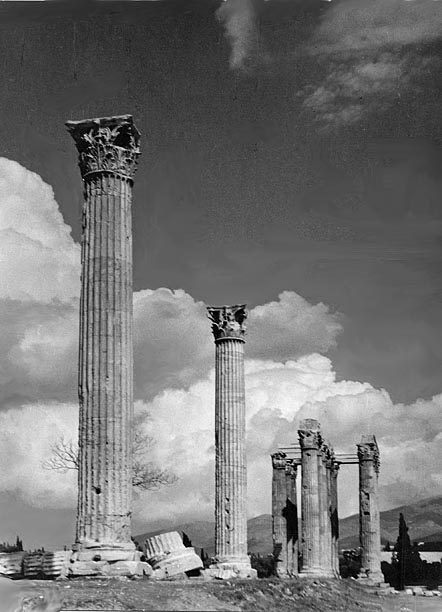
|
Opposite to and below the Acropolis is the Temple of the Olympian Zeus - on the same cloudy day.
Athens and the Hymettos from the hill of Philopappos in the evening. The columns of the Olympeion are seen in the right middle ground.
Monastery of Kaiseriani
4 and 6 September, 1953
Hidden under old plane-trees in a forest of pines on Mount Hymettos lies the Byzantine monastery of Kaiseriani. It has a lilting spring near its entrance, which was already famous in antiquity. Arguably the most idyllic spot near Athens. Gerhard and I had been there on our failed attempt to reach Sounion via Mt. Hymettos. While Gerhard was lying in bed with a tonsillitis I took Janet, an English botany student from Cambridge, who also stayed at our student dormitory to Kaiseriani. We enjoyed an afternoon and an unforgotten sunset up there returning rather late to Athens. This was the one time in all our life together where Gerhard blew up at me, complaining of being neglected and abandoned.
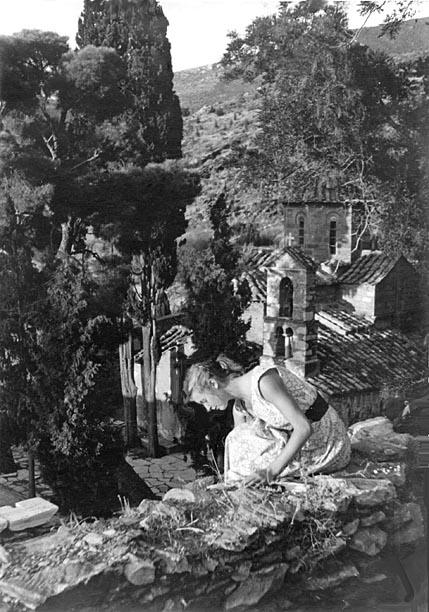
|
Kaiseriani. Janet Abrams collecting mosses for her research project at Cambridge University.
In our third week in Athens we climbed across the highest point of Mount Hymettos to reach the southern tip of Attika and Sounion. There existed no road to the top as today, we had to jump from rock to rock, "cross country." Half dead of thirst we reached a farm house on the southern side near where we spent a restless night. Next day Gerhard ran a high temperature and we had to return to Athens by bus....
The Hymettos from the south near Koropi in Attika where we spend the night before returning to Athens.
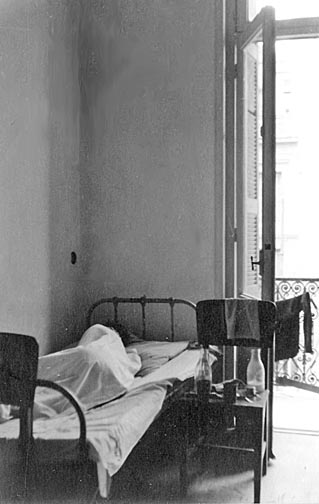
Gerhard sick in bed, Odos Patission |
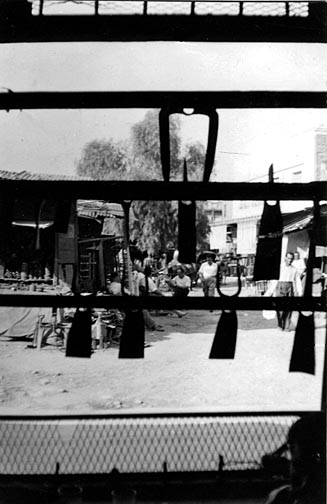
Odos Hephaistos the street of the black-smiths |
I bought hydrogenperoxyde and some throat lozenges for Gerhard, and when he was better again we took the train to Lavrion, the old silver mine of the Athenians and from there walked along the coast to Sounion. Now I had a throat ache and gargled for two days with sea water.
Sounion
5 - 7 September, 1953
|
|
The sea from our hike to Sounion
|
|
Poseidon temple and the islands. Sounion, blown by the salty sea winds, is the only white temple in Greece.
|
|
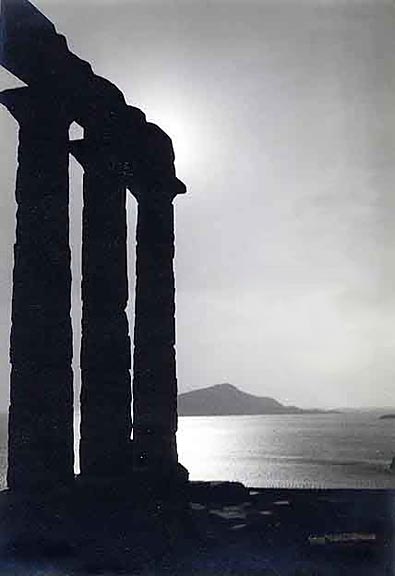
|
The sun above the sea.
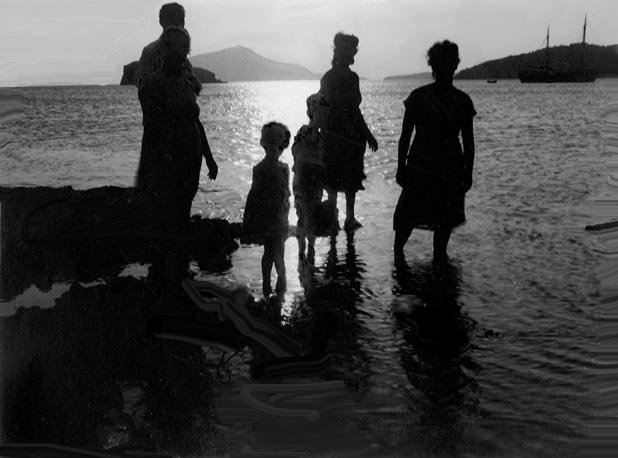
|
We slept on the beach below the temple - today there is a big tourist hotel at the spot. Late in the afternoon a family appeared from their field work to cool off and wash their feet.
Sunset at Sounion
Monastery of Daphni
8 September 1953
Outside of Athens, on the busy road to Eleusis and Korinthos lies the exquisite Byzantine monastery of Daphni. It harbors the most sophisticated 11th -century gold-ground mosaics in the Greece.
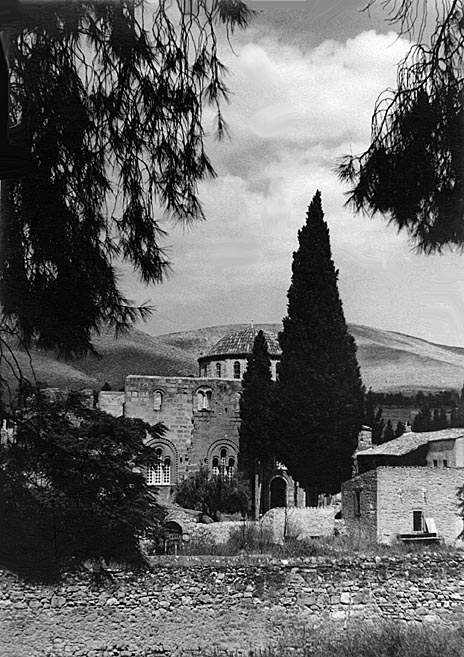
|
Daphni stands on the foundations of a temple to Aphrodite and Artemis, it was a way station along the processional road to the mystery plays at Eleusis.
|
|
The courtyard of Daphni
|
|
In 1953 there used to be an Ionian column built into the wall of the moni. It has been removed in the restorations of 1957.
Korinth and Patras
1-3 September 1953
Girorgios Stathakopoulos had invited us to his wedding. We took the train to Patras (10 hours!) and on the way spent a day in Korinth. We walked all the way to Palaia Korinthos with the ruins of city and a temple to Apollo. Later we climbed Akro- Korinthos with its huge ruined Franco-Venetian-Turkish fortress and a splendid view.
Apollo Temple and the mountains of Delphi across the Gulf of Korinth.
Walls of the Venetian "Kastro" at Akrokorinthos
|
|
View of the Peloponnisos from Akrokorinthos
The Island of Aigina
10 - 12 September, 1953
Aigina lies in the middle of the Saronic Gulf between Attika and the Peleponnes. Beneath the island mountain, once sacred to the Panhellenian Zeus (now occupied by Aghios Elias), are the ruins of the temple of Aphaia, a manifestation of the Cretan Artemis-Britomaris and a daughter of Zeus. I had seen the excavated frieze of the temple in Munich.... This and the fact that Aigina is on the boat route to the Troizinias, Epidauros, and the Peloponnisos made me decide to take the cheapest, slowest ship to the island and on to Poros.
The Doric columns of the Temple of Aphaia
View of Southern Aigina and Mt. Elias. We spent two days hiking across Aigina - and celebrating my twenty-second birthday with a self-cooked fish dinner on the beach below the temple.
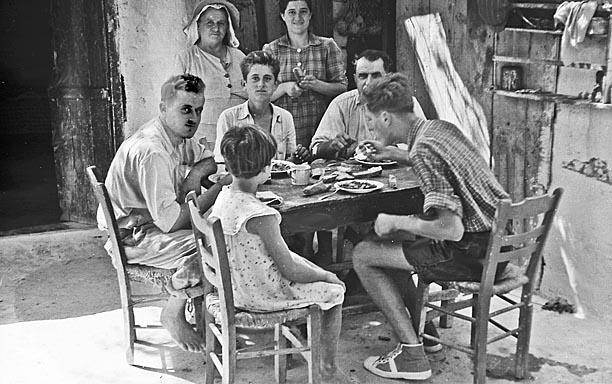
Invited for a noon meal by fishermen in Aigina |
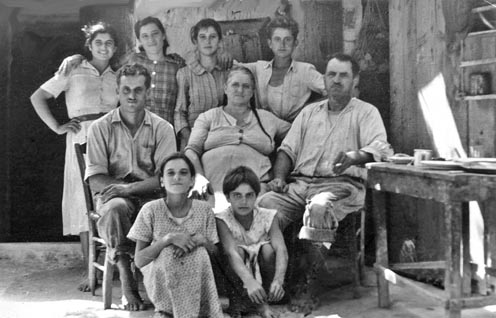
The entire family |
Next morning we hiked on through the hilly back-country in the southwest of the island. An inquiry for the right donkey path brought us to this fisherman's family who obliged us to share their meal: the women served the guests and men - like in Biblical times....
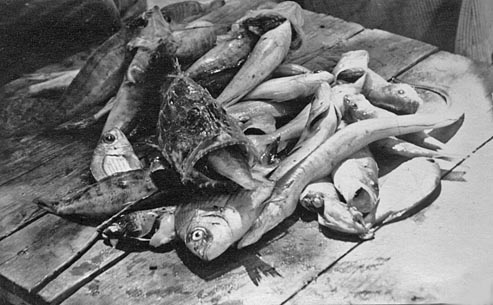
Their meager catch of fish |
The Aegean Sea is so clear because it contains very little plankton and consequently few fish. Our new friends shrugged, the bigger ones eat the smaller ones, there is not much to catch, but they offered us raw sea urchins which tasted very good. |
Eventually the exceptionally beautiful young girl standing behind the matriarch was delegated to show us the path - barefoot.
|
|
A rare Praying Mantis on one of the ubiquitous thistles.
The decision to reach the Peleponnes via Poros was fateful. On that boat we were befriended by Nonda Spiliotopoulos, the heir to a large shipping business. Attracted by Gerhard (which I only figured out later) he invited us to his summer house on the island of Poros.
Poros
12 - 19 September, 1953
When we arrived in Poros Nonda and his sister Daisy were waiting for us with their little boat to take us to his villa on the Peloponnesian side of the narrow strait.
The village of Poros from Nonda's "villa" in 1953.
.
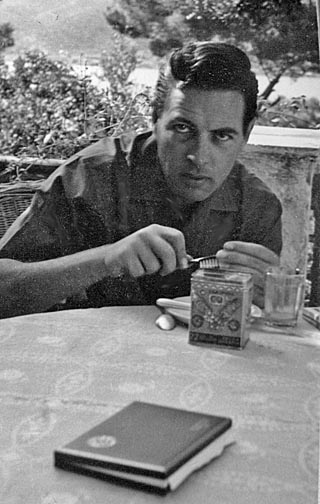
|
|
Here they are, Nonda cleaning his sister's jewelry with a toothbrush - a pack of expensive Greek cigarettes in the foreground - and charming Daisy (Dionysia) grooming the deaf, sixty-equivalent-year-old dog Anthony. We spent a wonderful week with them. Long talks on the terrace, wrapped by the scent of pines, bathed in moon light, in three languages - their mother had been German, Nonda had gone to college in England, and if needed he was equally fluent in French - on music, art, and literature into the small hours of the morning. Excellent retsina, strong kafelaki after dinner, and the best cigarettes available. On the weekend arrived four more guest, a Greek medical doctor and his German wife Ingeborg, a young woman from the French embassy, and Pavlos, a boring Greek shipping agent - Daisy's suitor at the time. On that weekend I decided that my house would one day be as open as Nonda's.....
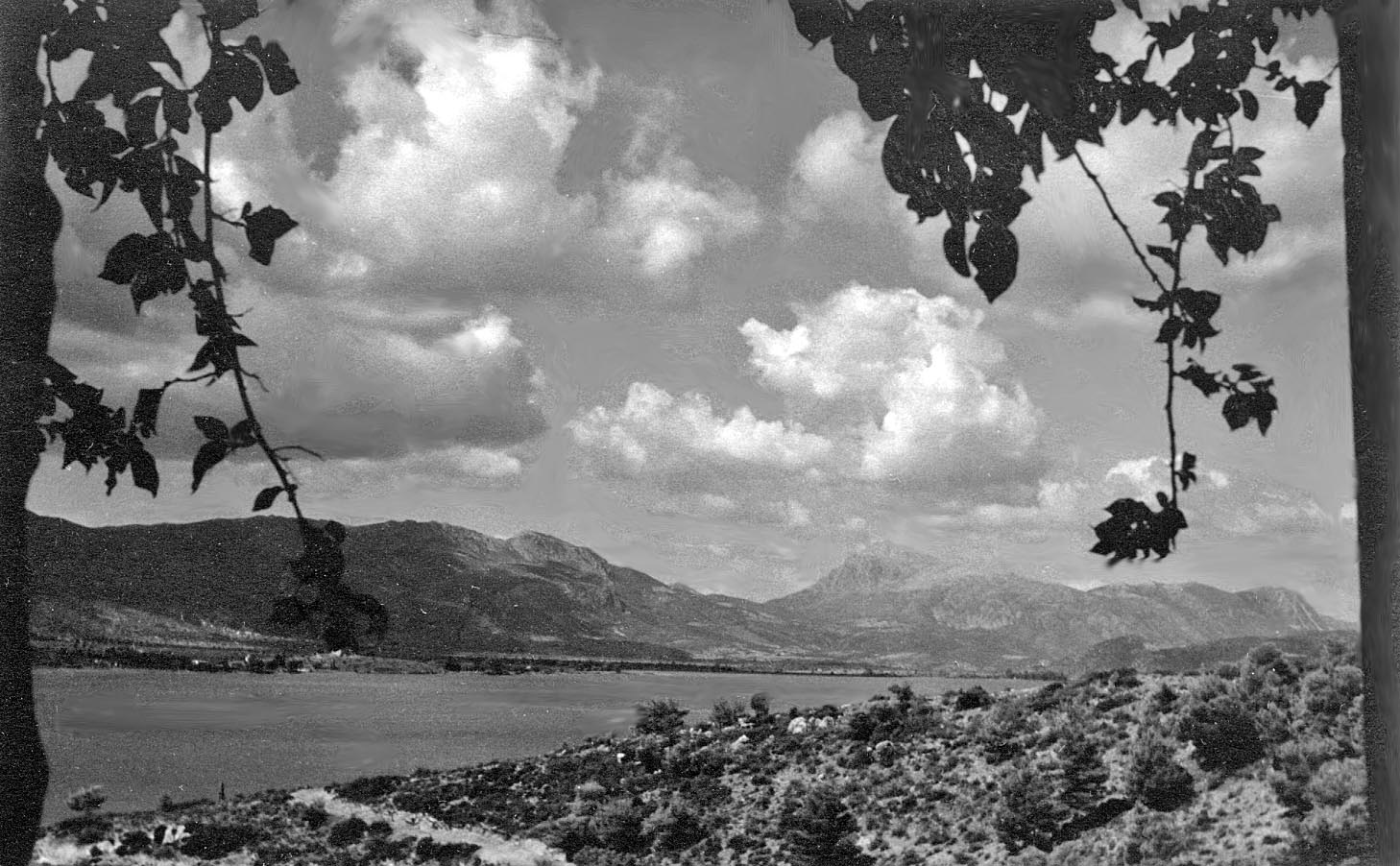
View of the Troizinias and the "Sleeping Woman" from Nondas terrace |
At the end of the week Nonda went to Athens and on his return told us that we had to leave, he expected Pavlos and another business associate for the week-end. He stuffed our pockets with cigarettes, took us across the channel, and "Please no sentimentalities!" hugged us goodbye: And we walked again, along the gulf behind Methana, over the ridge of the Sleeping Woman where, at Ano Phanari, a Greek who had been to America took us in and put us up in a spare room. A day later we reached
Epidauros
21 - 22 September, 1953
View from the upper tiers of the theater of Epidauros.
Most of the day we explored this curious "spa" with a theater for over 2000 spectators - located essentially nowhere... And the cures were effectively psychotherapy - the God appeared in the dream of the sleeper.... All this would occupied me for many years to come.
|
|
Stage entrance of the theater.
After an unpleasant encounter with an English couple in a Jaguar - the only tourists around - we took a bus to Nauplia, climbed the Palamides, the Franco-Venetian castle at sunset and next morning started to walk towards Mykenai.
The fortified island of Vourtsi in the Bay of Nauplia and the Peleponnes in the background. The conical hill of the kastro of Argos.
Somewhere in the Argolid a peasant with a two-wheeler donkey-cart picked us up for a few kilometers. He concluded his long speech on his "faith" - Communism with the exclamation, "all Germans boom, boom! But you are ok...." and invited us to a bottle of red wine - at high noon! Slightly dizzy we walked on.
|
|
The good Greek Communists at the cantina in the Argolis
The Gateway of Tyrins. On the way we explored the cyclopean ruins of Tyrins for a few hours.
View of the Argolid and the Argolian Gulf - the island of Vroutsi is visible on the left - from the citadel of Tyrins.
Mykenai
22 September, 1953
|
Mykenai from the olive groves of the modern village |
We arrived in Mykenai late in the afternoon. You can barely make out the citadel of the Atrides on this picture. It lies just below the shadow on Mt. Zacha. in pre-Hellenic times it was sacred to the Goddess and from there she mercilessly pursued the frivolous northern men who had built their castle in her precinct - until Orestes, the last man of his clan, half-mad because of his matricide, was absolved from her curse by the Council of Athens helped by Athena
As one gets nearer the low hill with the citadel of the northern invaders stands out below Mt. Zacha. To the pre-Hellenic people, much as it still is in Tibet, certain topological formations of the earth were sacred: Mt. Zacha was the head of the Great Goddess and the two hills below it her breasts - separated by a chasm that stood at the same time for her sex. The provocative position of the castle of the Atrides on this sacred manifestation was the hidden cause for the vicious wrath with which the Goddess persecuted the Hellenic men for a millenium - down to Orestes' matricide.
The Argolid from Mykenai.
We spent an unforgettable full-moon night on the roof of the hut of the archeologists. A warm wind blew from the Peleponnes. An English archeologist had joined us late at night and started to recite the tale of the massacre with which Klytemnestra, the priestess of the Goddess, and her lover Aigisthes received Agamemnon on his return from Troy. She prepared a bath for the tired hero and then threw a net over him. Aighistes easily cut down the defenseless, naked hero, and Klytemnestra castrated the dying man in the tub and for good measure hacked-off his head with the sacred ax of the Goddess. With Agamemnon died 18 adults among them Kassandra and the twins she had borne him - exactly as Schliemann found them. "People were slaughtered like pigs," writes Pausanias, "and Klytemnestra declared the day a feast day in honor of the Goddess." - I still shudder when I am in Mykenai....
Arkadia
23 - 29 September, 1953
Because hitch-hiking had turned out to be very poor we took the train to Megalopolis next day, a journey of six hours.. In Megalopolis we walked out of town into a full-moon night. Dogs howling, a flock of sheep in the moonlight, the smell of pines, flickering lights on the graves of a cemetery. We found a place to sleep in a pine wood climbing a hill. Apparently the shepherds had noticed us and in the middle of the night drove their bleating flock towards us.... Next morning we discovered that our hill was the backside of the theater of the once prosperous Hellenistic town of Megalopolis.
Our noon rest we shared with this dangerous looking bull
We walked on to Karytaina, a lively medieval village crowned by a castle of Guillaume de Villehardouin, the crusader who defeated and usurped the throne of the last Byzantine emperor in Mystras. Today the village is a ghost town....
View of the plain of Megalopolis from the castle hill of Karytaina
The river Alpheios below the village. The circular enclosures are threshing grounds.
|
|
The Alpheios gorge below Karytaina. Our path crossed the river on the stepping stones to the lower right The narrow path is barely visible in the picture. We had become very good in finding our path be the smallest details, a fresh scrape on the ground, a dislodged stone or a broken plant. From here we walked for two days along a stony road towards Andritsena. Once a day an overcrowded bus passed us - which we waved on.
The crusader castle of Karytaina in the distance from the road to Andritsena.
In 1953 Andritsena was a lively, picturesque market town. Somewhere high in the mountains south of it lies the lonely temple of Bassai (pronounced Vasse in modern Greek). How to find it? On our way we had met an archeology student from Freiburg who drew a sketch of the foot path to Bassai, but no one in Andritsena could point us in the right direction. My Greek was too poor. We found the path after two hours of searching for the right cemetery and a telephone line, the Freiburger had indicated.
Bassai
26 - 27 September, 1953
The Apollo Temple at Bassai in 1953 before it was badly damaged by an earthquake in the 1980s. According to Pausanias it was built by Ichtinos, the architect of the Parthenon. Architecturally it is the oddest Greek temple, directed to the south (not the east) with a single Ionic column in place of the altar, and a small door towards the east. The venerable ivory image of Apollo stood on the side, facing east through this side door.
|
|
Two Doric columns in the south cella
We slept in the sun-heated southern cella. It was late September and the nights were cold far from the warm sea. Very early next morning a girl appeared from nowhere with a bowl of sheep's milk for the xenoi - the foreign guests....
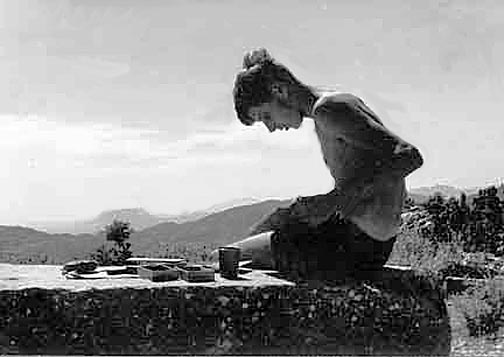
|
In the morning Gerhard painted the view while I took pictures.
Morning view to the west and the Ionian Sea.
Gerhard's watercolor is lost, but the slide of the view south has survived. In the far distance to the left is the craggy line of Mt. Taÿgetos and on the right the square block of Mt. Ithome in Messenia, behind it the sea. These two days were the culmination of our Greek journey in 1953.
|
|
A shepherdess spinning wool. As shy as she was, she very unabashed suggested to make love to us.
We had discovered a new mode of walking at high speed on the stony donkey-paths: lifting the feet high with bent knees. Later I would discover that the American Indians and the Tibetan Lung-runners used the same funny gait. We now ran up and down the smaller hills.
In beautiful country, near Khorio Tripotamias we crossed the Alpheios to its the northern bank. We stripped to our underpants, carried the backpacks on our head, and waded into the uncertain waters. When the water had reached our waists two boys materialized from nowhere on the opposite bank and directed us to a shallower ford.
We had to come with them to their spiti- home in the village. We were quite formally introduced by the older boy to their father and mother "afto pateras einai kai efti einai i materas mou... "- this is father and this is my mother, and no excuses were accepted, we had to spend the night with his family - several sisters, three boys, all ages in one large room under a the rafters of a simple shingle-roof on the second floor of their traditional farmhouse. The animals occupied the ground floor, a balcony surrounded the upper story. Father expertly fried eggs for the xenoi - the guests over an open fire-pit in the small, separate kitchen, accompanied by dry dark psomi-- bread. One of the girls was sent out to fetch the village teacher who spoke some English.... All the age-old questions a xenos has been asked since the times of Odysseus: You are adelphoi-brothers? Do you still have a father and a mother and any other brothers and sisters? Where do they live? - so far away! Is your mother not worried about you....?
And then came the sleeping ritual. There was one bed which the parents shared - in which we had to sleep. Father and mother moved onto the balcony. From a big chest the girls took out rugs and wool blankets for everyone. First the boys then, after they had blown out the candle - there was no electricity - the girls bedded down in the remaining corner - all in the same large room.... Next morning under much giggling, the sun already streaked through the cracks in the roof, the xenoi were examined with much curiosity. After a very formal goodbye we were taken by the boy who had found us to the path to Olympia: he wished us Kalo taxidi! - a good trip....
Olympia
29 September - 1 October, 1953
|
The Temple of Hera in the Altis of Olympia |
I remember the Altis - the sacred precinct of Olympia, as a wonderfully peaceful pine wood - filled with the songs of migrant birds from northern Europe.
|
|
We spent a day of rest at the banks of the Alpheios. Our boat would leave from Patras at noon on 5 October, we would dawdle through the last week between Olympia and Patras.
|
|
We found a wooded spot above Kato Achaia near Patras and a beach where we could take a last swim in the Greek sea. The boat was crowded with soldiers on their way to Eipeiros to guard the Greek border with Yugoslavia - the Kosovo and Montenegro. The Adriatic waves were long and disconcerting that night, a thunderstorm hung over Eipeiros |
Pompeii and Paestum
10 and 11 October, 1953
When we reached Brindisi it began to rain. Hitch-hiking was dismal. After a wet night in the Trulli district of Apulia we took the train to Naples and decided to visit Pompeii and Paestum.
|
Pompeii, House of the Faun |
Pompeii, city gate and Mt. Vesuvio |
Pompeii needs no introduction but Paestum is less well known (south of Salerno). It was once a busy Greek harbor city that flourished between the 5th and the 3rd century AD. Now its ruins are scattered across an open landscape close to the sea, a most romantic place. Greece is full of stones, flat, arable land is scarce. The Athenians lived off their wits, and like today the young emigrated to where an easier life could be eked out. Magna Graecia was a fat land before the Romans ruined Sicily and Apulia by exhausting the soil
Magna Graecia, The romantic landscape of Paestum
|
Paestum, the Agora |
Vincent Scully has aptly called the Greek temples "Jewelry Boxes of the Gods" - they were not designed with people in mind, not as houses for the masses of faithful like the Christian churches. - However in Magna Graecia the Gods had lost their magic which in Greece was connected to the ominous signs of the surrounding earth, mountains, rocks, and chasms that had long before the New Gods been the realm of the Great Goddess in her various incarnations. The three temples at Paestum, all dedicated to Hera, are lined up, one next to the other with little imagination or reference to the landscape - colonial architecture....
Temple of Poseidon (actually a second Hera Temple, 450 BC) - However, this is, despite its preservation missing the elegance and sophistication of Athens. Compare the Temple of Poseidon with the Parthenon, and you'll see why Ichtinos was famous.
The Hera Temple at Paestum has retained some of the magical female power, and this photo with the heavy clouds, one of my favorites pictures, captures some of this feeling. The temples of Greece are not romantic buildings, but like the entire Greek culture a manifestation of a millenium of bloody fighting between the old female Goddess and the new male order.
|
|
The journey home became an Odyssey: rain in Italy, snow on the Brenner, autostop very difficult- we walked many miles.. It didn't get better in Germany. Finally I hitched a ride for us on a freight pram down the Neckar river to Heidelberg. In Gelnhausen Tante Magda gave us a bed for the night and 10 Marks. We reached Göttingen drenched and hungry but happy around 22 October....
October 1954 With Gerhard
In 1954 Gerhard and I returned to Greece. We had hitch-hiked to Istanbul and spent two months there and in western Turkey. We reached Athens by boat in an adventurous, semi-legal way from Kusadasi to the Greek island of Chios and from there during an uncomfortable, stormy night to Athens. We had to borrow money for this voyage from a German couple, no one would give us cash in Kusadasi or Chios against our letter of credit to the Bank of Greece. After a week in Athens and at Nonda's in Poros we set out to explore Northern Greece. Two days in Delphi left the greatest impression.
Delphi
Delphi, the Apollo Temple and the Sacred Precinct. The French-built Delphi Museum is visible on the right.
The Kastalian spring. The niches for votive statues are still visible. Here women who wanted a baby would bathe.
|
|
Delphi, the village in 1954
.
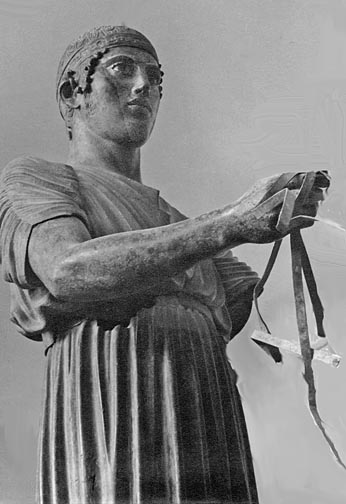
|
Delphi the Charioteer. A kind French lady at the Museum gave me permission to use my tripod.
|
|
.
.
The feet of the charioteer
|
|
The pass across the Parnassus high on a truck carrying Bauxit - aluminum ore.
Our truck at the bauxit "mine," a new German supported venture. We walked through most of Thessaly and then crossed the mountains - on a threshing machine - to Eipeiros.
|
|
Riding on a truck with grain bags north through the Eipeiros.
Eipeiros, the view from the top of the grain bags
After another crossing east over the mountains from Ioannina to Kalambaka, we marched north towards the Greek-Yugoslavian border. Mt Olympos from the west.
The last sunny day in Greece. The high ice clouds would soon overtake us and a cold rain began to make our life difficult.
We crossed into Yugoslavia by train, took a bus from Pec through the Kososvo and the Cerna Gora to the Adriatic coast at Kotor. In Dubrovnik we bought a boat ticket along the coast to Rijeka, where we slept a night on a park bench. In the morning Gerhard converted our last fifty cents into a loaf of bread, after had I bought tickets for the train to Salzburg, where we arrived at 4 o'clock in the morning, Luckily we found a ride on a bus filled with drunk Austrians on the way to the October Fest in München.... There we got some money from our postal savings account and ate at the Hofbräuhaus, but I don't remember how we got home....